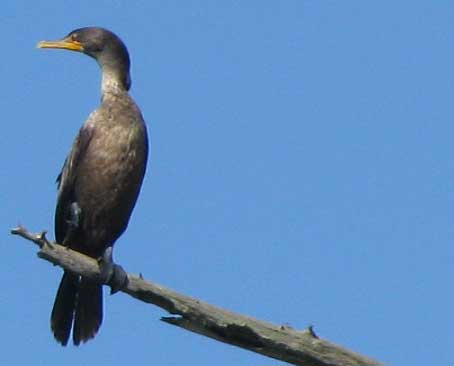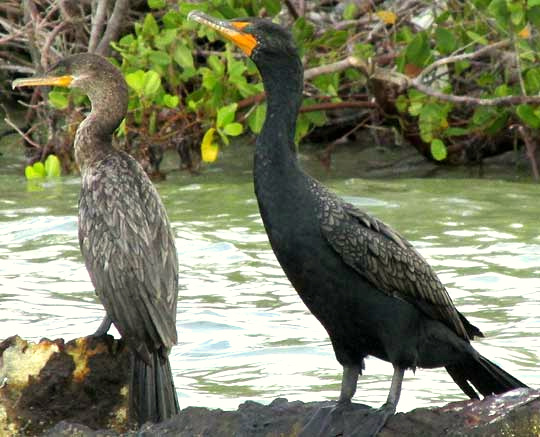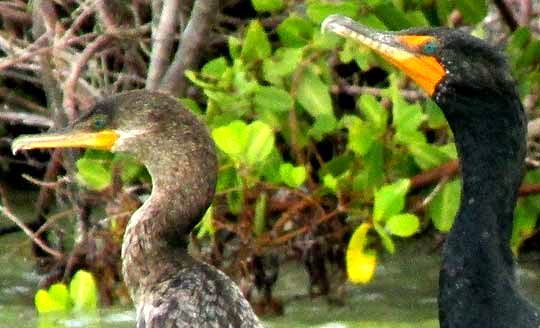Excerpts from Jim Conrad's
Naturalist Newsletter

from the December 21, 2014 Newsletter issued from Río Lagartos, on the north-central coast of Yucatán, MÉXICO
DOUBLE-CRESTED CORMORANT
Here and there in Ría Lagartos Estuary there are signs standing in open water explaining things to visitors in tour boats, and often one or more birds are picturesquely perched on the signs, usually pelicans, gulls, terns and cormorants. The other day our boatload of visitors from Poland wanted a closer look at a cormorant. As we approached, the cormorant spread his wings, providing the interesting picture shown above.
Of course cormorants often spread their wings exactly like this, to dry them against the sun and warm up, but it was interesting that this bird did it just as our boat was approaching so close that everyone expected the bird to fly instead.
I think it was a matter of "displacement behavior," which is usually thought of as self-grooming, touching, or scratching done when an animal, such as a cormorant or a human, is caught in a conflict between two drives. In this case, probably the bird both wanted to fly because he was getting nervous, but also wanted to stay, because flying away and getting all wet again is a drag. When a person experiences such conflicts, maybe he or she scratches the head or coughs.
Whatever the reason for spreading its wings, that's a Double-crested Cormorant, PHALACROCORAX AURITUS, the one commonly seen in much of North America, though in most inland locations only during summers and during migrations. Here they are just non-breeding winter visitors. We do have similar looking but smaller Neotropic Cormorants who stay here year round, though. You can tell that this is a Double-crested by the configuration of the fleshy area behind its bill. Notice the fleshy part between the eye and top of the bill. You can compare that with our Neotropic Cormorant at http://www.backyardnature.net/yucatan/cormoran.htm.
from the October 25, 2009 Newsletter, from near Natchez, Mississippi, USA
A NEWLY ARRIVED CORMORANT

Above you see a Double-crested Cormorant, PHALACROCORAX AURITUS, just arrived for the winter. Back when I wrote for Aquaculture Magazine I profiled many catfish farms in Mississippi's Delta Region, and nearly all the farms' owners had awful things to say about Double-crested Cormorants. Cormorants find snatching catfish from shallow ponds to be easy food, and their sheer numbers usually overwhelmed any predator controls the farmers could devise.
The summer/winter distribution maps of most migrant bird species neatly show that the birds are one place during the summer and another in the winter. The Double-crested Cormorant's map is sloppier. You might be interested in comparing their winter map here with their summer map showing where they nest here.
The summer map shows them breeding mostly in the north but also here and there in the southern states. This flexibility of behavior may prove very adaptive for them as global warming proceeds. It's documented that Double-crested Cormorants are increasing in numbers and expanding their distribution area.
Also flying around that day were some Anhingas, which look a lot like cormorants, except that Anhingas have sharp bills, while you can see that a cormorant's bill is rounded and hooked at the tip.
from the March 15, 2015 Newsletter issued from Río Lagartos, on the north-central coast of Yucatán, MÉXICO
NEOTROPIC & DOUBLE-CRESTED CORMORANTS SIDE BY SIDE
Yet another opportunity for a side-by-side comparison of two similar species was made possible this week with the grouping shown below:

On the left, that's our permanent-resident the Neotropic Cormorant, while on the right there's the Double-crested Cormorant, which along most of the Yucatan Peninsula's coast is a winter visitor, but which nests in certain dispersed breeding colonies along the coast.
Plumage colors are changeable and not dependable. However, the picture reminds us that Neotropic Cormorants are fairly consistently smaller than Double-cresteds. The most decisive difference, however, is seen on the "face." A close-up of the faces side-by-side is shown below:

Note that the Neotropic's bill connects with the feathered part of the head forming a kind of V-on-its-side, and that a whitish border is forming at the connection. In contrast, the Double-crested's orangish skin doesn't make such a connection and there's no pale fringe. A more technical way of describing this is that on the Neotropic the "posterior edge of the gular skin is pointed," but that's not the case with the Double-crested. Also, note that the Double-crested has yellow skin above and in front of the eye, but the Neotropic doesn't.